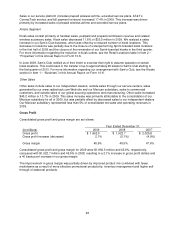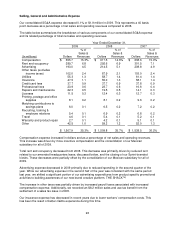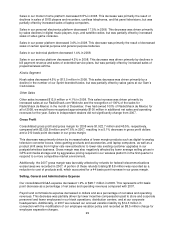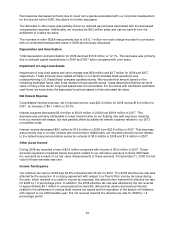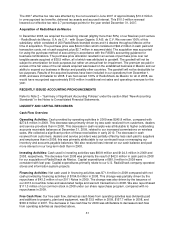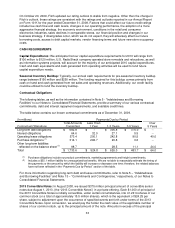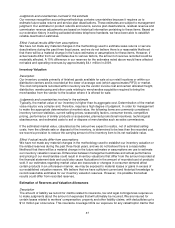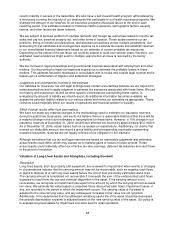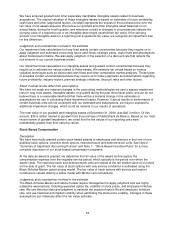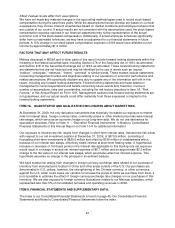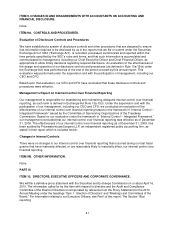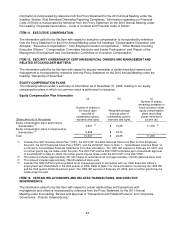Radio Shack 2009 Annual Report Download - page 40
Download and view the complete annual report
Please find page 40 of the 2009 Radio Shack annual report below. You can navigate through the pages in the report by either clicking on the pages listed below, or by using the keyword search tool below to find specific information within the annual report.
33
On October 20, 2009, Fitch updated our rating outlook to stable from negative. Other than the change in
Fitch’s outlook, these ratings are consistent with the ratings and outlooks reported in our Annual Report
on Form 10-K for the year ended December 31, 2008. Factors that could affect our future credit ratings
include free cash flow and cash levels, changes in our operating performance, the adoption of a more
aggressive financial strategy, the economic environment, conditions in the retail and consumer
electronics industries, sales declines in comparable stores, our financial position and changes in our
business strategy. If downgrades occur, which we do not expect, they will adversely affect our future
borrowing costs, access to debt capital markets, vendor financing terms and future new store occupancy
costs.
CASH REQUIREMENTS
Capital Expenditures: We anticipate that our capital expenditure requirements for 2010 will range from
$100 million to $120 million. U.S. RadioShack company-operated store remodels and relocations, as well
as information systems projects, will account for the majority of our anticipated 2010 capital expenditures.
Cash and cash equivalents and cash generated from operating activities will be used to fund future
capital expenditure needs.
Seasonal Inventory Buildup: Typically, our annual cash requirements for pre-seasonal inventory buildup
range between $150 million and $250 million. The funding required for this buildup comes primarily from
cash on hand and cash generated from net sales and operating revenues. Additionally, our credit facility
could be utilized to fund the inventory buildup.
Contractual Obligations
The following tables, as well as the information contained in Note 5 - "Indebtedness and Borrowing
Facilities" to our Notes to Consolidated Financial Statements, provide a summary of our various contractual
commitments, debt and interest repayment requirements, and available credit lines.
The table below contains our known contractual commitments as of December 31, 2009.
(In millions) Payments Due by Period
Contractual Obligations
Total Amounts
Committed
Less Than
1 Year
1-3 Years
3-5 Years
Over
5 Years
Long-term debt obligations $ 682.8 $ -- $ 306.8 $ 376.0 $ --
Interest obligations 64.6 32.0 27.1 5.5 --
Operating lease obligations 573.4 200.1 242.8 90.5 40.0
Purchase obligations (1) 314.1 292.7 20.8 0.6 --
Other long-term liabilities
reflected on the balance sheet (2)
98.7
28.5
11.1
24.0
Total $ 1,733.6 $ 524.8 $ 626.0 $ 483.7 $ 64.0
(1) Purchase obligations include our product commitments, marketing agreements and freight commitments.
(2) Includes a $35.1 million liability for unrecognized tax benefits. We are not able to reasonably estimate the timing of
the payments or the amount by which the liability will increase or decrease over time; therefore, the related balances
have not been reflected in the ‘‘Payments Due by Period’’ section of the table.
For more information regarding long-term debt and lease commitments, refer to Note 5 – “Indebtedness
and Borrowing Facilities” and Note 13 – “Commitments and Contingencies,” respectively, of our Notes to
Consolidated Financial Statements.
2013 Convertible Notes: In August 2008, we issued $375 million principal amount of convertible senior
notes due August 1, 2013, (the “2013 Convertible Notes”) in a private offering. Each $1,000 of principal of
the 2013 Convertible Notes is initially convertible, under certain circumstances, into 41.2414 shares of our
common stock (or a total of approximately 15.5 million shares), which is the equivalent of $24.25 per
share, subject to adjustment upon the occurrence of specified events set forth under terms of the 2013
Convertible Notes. Upon conversion, we would pay the holder the cash value of the applicable number of
shares of our common stock, up to the principal amount of the note. Amounts in excess of the principal




